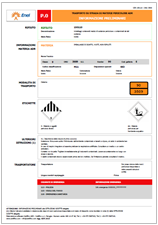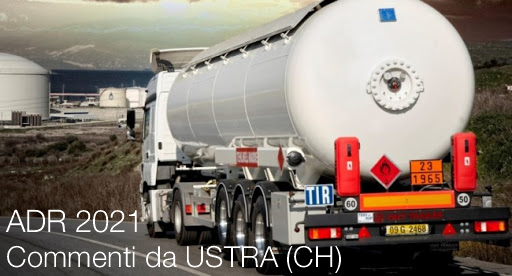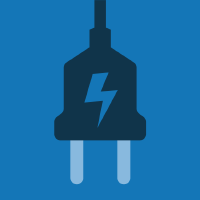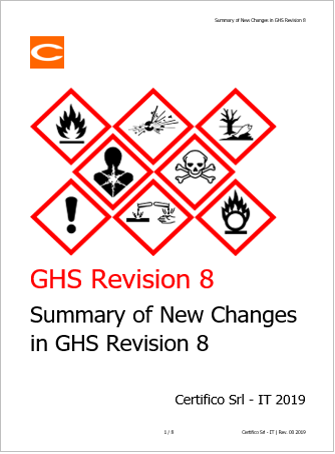
Summary of New Changes in GHS Revision 8
Update 14.07.2019
On 18 March 2019, the Committee of Experts on TDG and GHS of the UNECE has published approved amendments (in attachment) to the seventh revised edition of UN GHS purple book. These changes are going to be included in the 8th edition of UN GHS purple book (GHS rev. 8) to be published in July 2019.
Change of classification criteria for aerosols
Aerosols are to be classified in one of the three categories, according to Table 2.3.1. The category will depend on:
- their flammable properties
- their heat of combustion
- if applicable, test results from the ignition distance test, the enclosed space ignition test and the aerosol foam flammability test, performed in accordance with subsections 31.4, 31.5 and 31.6 of the United Nations Recommendations on the Transport of Dangerous Goods, Manual of Tests and Criteria.
Table 2.3.2: New GHS Classification Criteria for Aerosols
|
Category
|
Criteria
|
|
1
|
1.) Any aerosol that contains ≥ 85% flammable components (by mass) and has a heat of combustion of ≥ 30 kJ/g
2.) Any aerosol that dispenses a spray that, in the ignition distance test, has an ignition distance of ≥ 75cm
3.) Any aerosol that dispenses a foam that, in the foam flammability test, has:
- a heat of combustion of ≥ 20cm and a flame duration of ≥ 2 seconds
- a flame height of ≥ 4cm and a flame duration of ≥ 7 seconds
|
|
2
|
1.) Any aerosol that dispenses a spray that, based on the results of the ignition distance test, does not meet the criteria for Category 1 and which has:
- a heat of combustion of ≥ 20 kJ/g
- a heat combustion of < 20 kJ/g and an ignition distance of ≥ 15 cm
- a heat of combustion of < 20 kJ/g and an ignition distance of < 15cm along with either, in the enclosed space ignition test:
- a time equivalent of ≤ 300 s/m3
- a deflagration density of ≤ 300 g/m3
2.) Any aerosol that dispenses a foam that, based on the results of the aerosol foam flammability test, does not meet the criteria for Category 1, and which has a flame height of ≥ 4cm and a flame duration of ≥ 2 seconds
|
|
3
|
1.) Any aerosol that contains ≤ 1% flammable components (by mass) and that has a heat of combustion of < 20 kJ/g
2.) Any aerosol that contains > 1% (by mass) flammable components or which has a heat of combustion of ≥ 20 kJ/g but which, based on the results of the ignition distance test, the enclosed space ignition test or the aerosol foam flammability test, does not meet the criteria for Category 1 or Category 2
|
Corresponding hazard statements and pictograms for chemicals under pressure are listed as below.
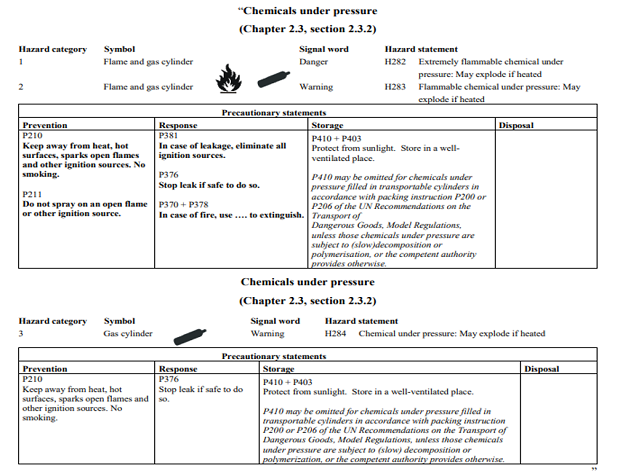
New precautionary pictograms equivalent to the precautionary statement P102 “Keep out of reach of children”
There is a proposal to include in the GHS a pictogram to be used in addition to P102 “Keep out of reach of children”, and a paper proposing a rationalisation and simplification of P201 and P202.
Several scientific studies have confirmed that visual representations or pictograms can be recognised more quickly and intrinsically trigger more spontaneous interest than written warnings. One such study concluded that “inclusion of GHS hazard pictograms and precautionary pictograms to SDS and labels may benefit the user”. It is estimated that about 14% of the world’s population cannot read and so the use of simple and intuitive precautionary pictograms can be an effective means to convey essential safe use information on hazardous chemicals.
The objective of the proposal is to seek a common way — at the global level — to help reduce the number of incidents where young children come into contact with chemicals, through the adoption of one simple and intuitive precautionary pictogram to convey the message “Keep out of reach of children” (Precautionary Statement P102). This can be achieved by including this precautionary pictogram in s.5 of Annex 3 of GHS.
The following examples convey the meaning of precautionary statement P102 “Keep out of reach of children” and may be used to convey information in more than one way accordingly. One pictogram is from the International Association for Soaps, Detergents and Maintenance Products (AISE), while the other one is from the Japan Soap & Detergent Association (JSDA). It will be important for the labelling of chemical products supplied to the public.
Safe use icon “Keep out of reach children used by the AISE and safe use icon developed by the JSDA
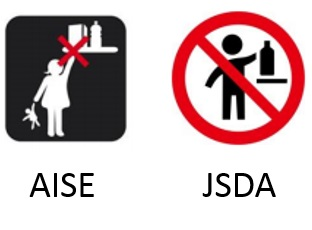
The intention is to add the precautionary pictograms to the GHS (Annex 3 s.5 after paragraph A3.5.1.).
New labelling example for sets or kits
It is intended to further improve the examples for sets or kits by adding a new example “Labelling of sets or kits” in Annex 7 of the GHS.
Scenario A
The set or kit comprises an outer packaging containing the following inner containers.
Four cuvettes, each filled with the same substance or mixture (Reagent 1).
Two larger containers each filled with another substance or mixture (Reagent 2).
The approach is to provide minimum information on each of the inner containers containing hazardous substances or mixtures, and to provide the full GHS label information for each hazardous substance or mixture on the outer packaging. For clarity, the full label information for each hazardous substance or mixture is grouped together on the outer packaging.
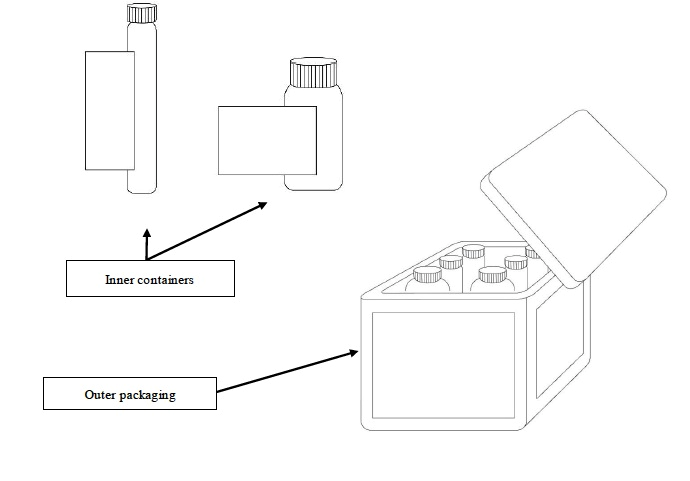
...
add more in attachment
Certifico Srl - IT | Rev. 00 2019
©Copia Autorizzata Abbonati
Collegati
Allegati
|
Descrizione |
Lingua |
Dimensioni |
Downloads |
 |
Abbonati Merci Pericolose
|
EN |
1358 kB |
9 |
 |
Abbonati Merci Pericolose
|
EN |
310 kB |
18 |
